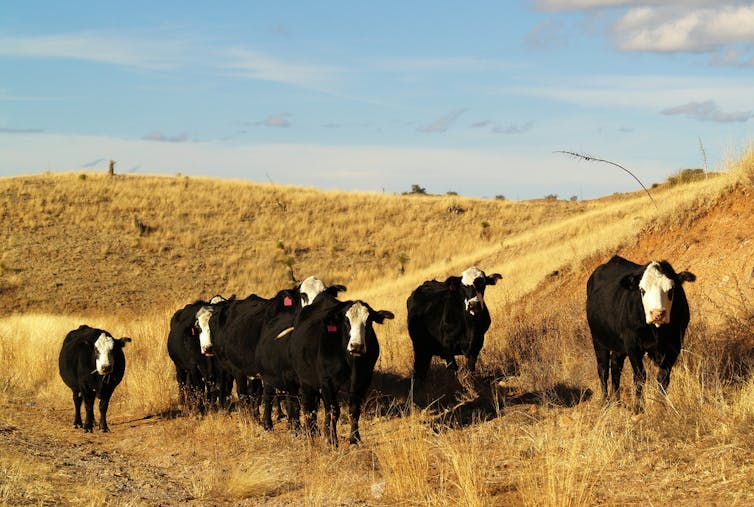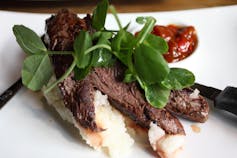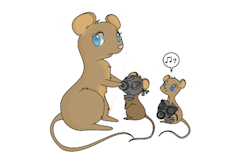How Many Small Animals Are Killed Each Year By Agriculture
This article was published in 2011. A follow-up article refuted its claims.
The ethics of eating crimson meat take been grilled recently by critics who question its consequences for environmental health and creature welfare. But if you lot want to minimise animal suffering and promote more than sustainable agriculture, adopting a vegetarian diet might exist the worst possible thing you could practice.
Renowned ethicist Peter Singer says if in that location is a range of ways of feeding ourselves, we should choose the way that causes the least unnecessary harm to animals. Virtually beast rights advocates say this means nosotros should consume plants rather than animals.
Information technology takes somewhere between two to 10 kilos of plants, depending on the blazon of plants involved, to produce one kilo of animal. Given the limited amount of productive land in the world, it would seem to some to make more sense to focus our culinary attentions on plants, because nosotros would arguably get more free energy per hectare for homo consumption. Theoretically this should also hateful fewer sentient animals would be killed to feed the ravenous appetites of e'er more humans.
Just before scratching rangelands-produced red meat off the "expert to eat" list for ethical or environmental reasons, let's test these presumptions.
Published figures suggest that, in Commonwealth of australia, producing wheat and other grains results in:
- at least 25 times more sentient animals being killed per kilogram of useable protein
- more environmental damage, and
- a groovy deal more animal cruelty than does farming red meat.
How is this possible?
Agriculture to produce wheat, rice and pulses requires clear-felling native vegetation. That act solitary results in the deaths of thousands of Australian animals and plants per hectare. Since Europeans arrived on this continent we have lost more than than half of Australia's unique native vegetation, mostly to increment product of monocultures of introduced species for human being consumption.
Most of Australia's arable land is already in use. If more Australians want their nutritional needs to exist met by plants, our arable country will need to be even more intensely farmed. This will require a net increase in the utilize of fertilisers, herbicides, pesticides and other threats to biodiversity and environmental wellness. Or, if existing laws are changed, more than native vegetation could be cleared for agriculture (an area the size of Victoria plus Tasmania would exist needed to produce the boosted amount of plant-based food required).

Most cattle slaughtered in Commonwealth of australia feed solely on pasture. This is ordinarily rangelands, which constitute near lxx% of the continent.
Grazing occurs on primarily native ecosystems. These have and maintain far higher levels of native biodiversity than croplands. The rangelands tin't be used to produce crops, and so production of meat here doesn't limit product of constitute foods. Grazing is the but way humans can get substantial nutrients from seventy% of the continent.
In some cases rangelands accept been essentially altered to increase the pct of stock-friendly plants. Grazing can also crusade pregnant harm such as soil loss and erosion. Merely it doesn't result in the native ecosystem "blitzkrieg" required to grow crops.
This environmental damage is causing some well-known environmentalists to question their ain preconceptions. British environmental advocate George Monbiot, for example, publically converted from vegan to omnivore afterward reading Simon Fairlie's expose most meat'south sustainability. And ecology activist Lierre Keith documented the crawly damage to global environments involved in producing plant foods for human consumption.
In Commonwealth of australia we can as well meet part of our protein needs using sustainably wild-harvested kangaroo meat. Unlike introduced meat animals, they don't damage native biodiversity. They are soft-footed, low methane-producing and accept relatively low water requirements. They too produce an exceptionally salubrious low-fatty meat.
In Australia 70% of the beef produced for human consumption comes from animals raised on grazing lands with very little or no grain supplements. At any time, only two% of Commonwealth of australia'south national herd of cattle are eating grains in feed lots; the other 98% are raised on and feeding on grass. Two-thirds of cattle slaughtered in Australia feed solely on pasture.
To produce poly peptide from grazing beef, cattle are killed. One expiry delivers (on average, across Australia's grazing lands) a carcass of near 288 kilograms. This is approximately 68% boneless meat which, at 23% protein equals 45kg of poly peptide per animal killed. This means ii.two animals killed for each 100kg of useable animal protein produced.
Producing poly peptide from wheat means ploughing pasture state and planting information technology with seed. Anyone who has sat on a ploughing tractor knows the predatory birds that follow you all mean solar day are not there because they have nothing better to do. Ploughing and harvesting impale small mammals, snakes, lizards and other animals in vast numbers. In addition, millions of mice are poisoned in grain storage facilities every year.
However, the largest and best-researched loss of sentient life is the poisoning of mice during plagues.

Each area of grain production in Australia has a mouse plague on average every four years, with 500-1000 mice per hectare. Poisoning kills at least 80% of the mice.
At least 100 mice are killed per hectare per year (500/4 × 0.8) to abound grain. Boilerplate yields are virtually one.four tonnes of wheat/hectare; 13% of the wheat is useable protein. Therefore, at least 55 sentient animals dice to produce 100kg of useable plant protein: 25 times more than than for the same amount of rangelands beefiness.
Some of this grain is used to "cease" beef cattle in feed lots (some is food for dairy cattle, pigs and poultry), but it is nevertheless the case that many more than sentient lives are sacrificed to produce useable protein from grains than from rangelands cattle.
There is a further issue to consider here: the question of sentience – the chapters to feel, perceive or be conscious.
You might not think the billions of insects and spiders killed by grain production are sentient, though they perceive and reply to the world effectually them. You may dismiss snakes and lizards every bit cold-blooded creatures incapable of sentience, though they form pair bonds and care for their young. But what about mice?
Mice are far more sentient than nosotros thought. They sing complex, personalised love songs to each other that get more than complex over time. Singing of any kind is a rare behaviour among mammals, previously known only to occur in whales, bats and humans.
Girl mice, like swooning homo teenagers, try to get close to a skilled crooner. Now researchers are trying to determine whether vocal innovations are genetically programmed or or whether mice learn to vary their songs every bit they mature.

Baby mice left in the nest sing to their mothers — a kind of crying vocal to phone call them back. For every female killed by the poisons we administer, on average five to six totally dependent baby mice will, despite singing their hearts out to call their mothers dorsum home, inevitably die of starvation, dehydration or predation.
When cattle, kangaroos and other meat animals are harvested they are killed instantly. Mice dice a ho-hum and very painful decease from poisons. From a welfare point of view, these methods are amidst the least acceptable modes of killing. Although joeys are sometimes killed or left to fend for themselves, only xxx% of kangaroos shot are females, only some of which will take immature (the industry's code of practice says shooters should avoid shooting females with dependent young). However, many times this number of dependent baby mice are left to dice when we deliberately poison their mothers by the millions.
Replacing ruby meat with grain products leads to many more sentient fauna deaths, far greater animal suffering and significantly more environmental degradation. Protein obtained from grazing livestock costs far fewer lives per kilogram: it is a more than humane, upstanding and environmentally-friendly dietary pick.
And then, what does a hungry man do? Our teeth and digestive system are adapted for omnivory. But we are at present challenged to think about philosophical issues. We worry about the ethics involved in killing grazing animals and wonder if at that place are other more humane ways of obtaining adequate nutrients.
Relying on grains and pulses brings devastation of native ecosystems, significant threats to native species and at least 25 times more deaths of sentient animals per kilogram of food. Most of these animals sing love songs to each other, until we inhumanely mass-slaughter them.
Former Justice of the High Courtroom, the Hon. Michael Kirby, wrote that:
"In our shared sentience, human beings are intimately connected with other animals. Endowed with reason and speech, nosotros are uniquely empowered to make ethical decisions and to unite for social change on behalf of others that have no voice. Exploited animals cannot protest about their treatment or demand a better life. They are entirely at our mercy. So every determination of animal welfare, whether in Parliament or the supermarket, presents usa with a profound test of moral graphic symbol".
We now know the mice have a voice, only we haven't been listening.
The claiming for the ethical eater is to cull the diet that causes the least deaths and environmental damage. There would announced to be far more than ethical support for an omnivorous diet that includes rangeland-grown red meat and even more than support for i that includes sustainably wild-harvested kangaroo.
Thanks to many colleagues including Rosie Cooney, Peter Ampt, Grahame Webb, Bob Beale, Gordon Grigg, John Kelly, Suzanne Hand, Greg Miles, Alex Baumber, George Wilson, Peter Banks, Michael Cermak, Barry Cohen, Dan Lunney, Ernie Lundelius Jr and anonymous referees of the Australian Zoologist paper who provided helpful critiques.
Editor'southward note: since this article was published in 2011 its information have been disputed. A 2018 paper in the Journal of Agricultural and Environmental Ethics found this article:
-
overestimated the number of mouse plagues per hectare of grain farming, and mouse poisoning deaths, per yr
-
claims 55 sentient animals die to produce 100kg of usable establish protein when the right figure is ane.27 animals
-
does non take into account mouse deaths on grazing state.
Source: https://theconversation.com/ordering-the-vegetarian-meal-theres-more-animal-blood-on-your-hands-4659
Posted by: kellyhishentimed.blogspot.com

0 Response to "How Many Small Animals Are Killed Each Year By Agriculture"
Post a Comment